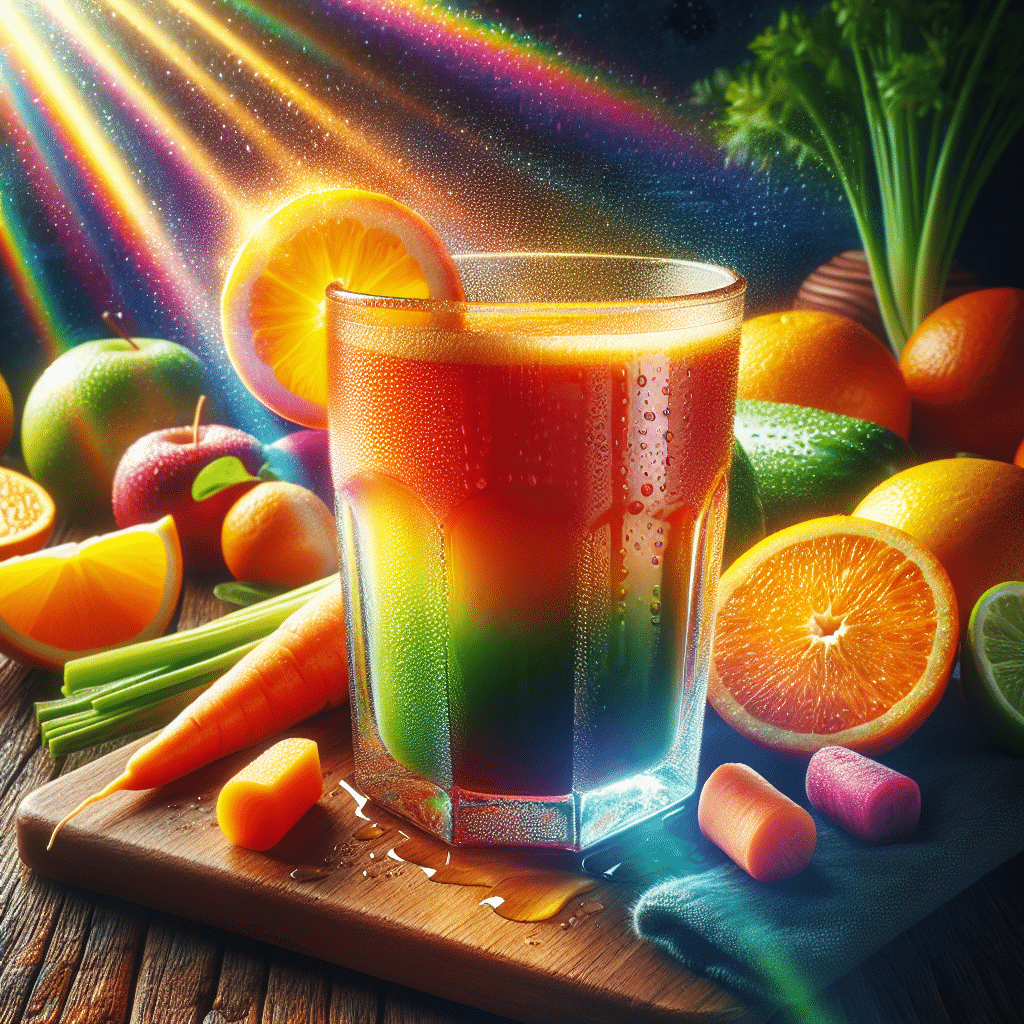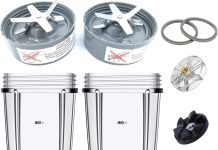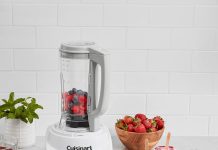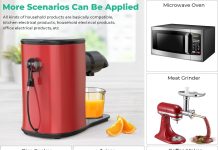Hey, are you thinking about buying a juicer but not sure where to start? Look no further! In this article, we will take you through the key features and considerations to keep in mind when purchasing a juicer. From different types of juicers to motor power and cleaning options, we have got you covered. So grab a cup of your favorite juice and let’s dive right in!
Review contents
Types of Juicers
Centrifugal Juicers
Centrifugal juicers are one of the most common types of juicers on the market. They work by using a high-speed spinning blade to extract juice from fruits and vegetables. These juicers are known for their fast juicing process, making them a popular choice for those who are always on the go or short on time. However, one drawback of centrifugal juicers is that they can produce slightly lower juice yields compared to other types of juicers.
Masticating Juicers
Masticating juicers, also known as slow juicers or cold press juicers, operate at a slower speed compared to centrifugal juicers. They work by crushing and pressing fruits and vegetables to extract juice. The slower speed helps to preserve the nutrients and enzymes in the juice, resulting in a higher quality juice with less oxidation. Masticating juicers are also great for juicing leafy greens and are generally quieter than centrifugal juicers. However, they can be a bit more expensive compared to centrifugal juicers.
Citrus Juicers
As the name suggests, citrus juicers are specifically designed for juicing citrus fruits such as oranges, lemons, and grapefruits. These juicers are typically simple in design, consisting of a cone-shaped reamer that is pressed into the fruit to extract the juice. Citrus juicers are efficient at extracting juice from citrus fruits, producing minimal pulp. They are a great option for those who primarily juice citrus fruits and are looking for a compact and easy-to-use juicer.
Triturating Juicers
Triturating juicers, also known as twin gear juicers, are considered the top-of-the-line juicers when it comes to juice quality and yield. They work by using two interlocking gears to crush and grind fruits and vegetables, extracting the maximum amount of juice. Triturating juicers are known for producing high-quality juice with minimal oxidation, as well as being efficient at juicing leafy greens. However, they tend to be more expensive and larger in size compared to other types of juicers.
Juice Yield
High Juice Yield
When it comes to juicers, a high juice yield is a desirable feature. It refers to the amount of juice that can be extracted from a given amount of fruits and vegetables. Juicers with a high juice yield are efficient at extracting juice, ensuring that you get the most out of your produce. Masticating and triturating juicers are known for their high juice yields, as they are designed to thoroughly extract every drop of juice from the produce.
Low Juice Yield
On the other hand, some juicers may have a lower juice yield compared to others. Centrifugal juicers, in particular, tend to have slightly lower juice yields due to their high-speed extraction process. While they may still produce a decent amount of juice, you may find that you need more fruits and vegetables to yield the same amount of juice compared to a masticating or triturating juicer. However, if you value speed and convenience over maximum juice yield, a centrifugal juicer may still be a suitable option for you.
Ease of Use
Assembly
The ease of assembly is an important factor to consider when choosing a juicer. Some juicers have a more complex assembly process, requiring you to attach multiple parts and follow specific instructions. On the other hand, there are juicers that have a simpler assembly process, allowing you to quickly set up and start juicing without any hassle. For those who value convenience and want a juicer that is easy to use, look for models with a straightforward assembly process.
Feeding Chute Size
The feeding chute size of a juicer refers to the opening through which you insert your fruits and vegetables. A larger feeding chute allows you to put whole or larger pieces of produce into the juicer without needing to pre-cut them into smaller pieces. This can save you time and effort in the preparation process. However, juicers with larger feeding chutes tend to be bulkier in size. If you have limited counter space or prefer a more compact juicer, you may have to compromise on the feeding chute size.
Pulp Ejection System
The pulp ejection system of a juicer determines how the extracted pulp is disposed of. Some juicers have an internal pulp ejection system, which means that the pulp is collected in a separate compartment within the juicer. This can be convenient as it eliminates the need to stop and empty the pulp container frequently. Other juicers may have an external pulp ejection system, requiring you to manually remove the pulp from a separate container. Consider your preference and convenience when choosing a juicer with regards to the pulp ejection system.
Power and Speed
Motor Power
The motor power of a juicer determines the strength and efficiency of the juicing process. A more powerful motor can handle tougher and harder fruits and vegetables, ensuring that you get a smooth and consistent juice. Centrifugal juicers tend to have higher motor power, making them suitable for juicing a wide range of produce. Masticating and triturating juicers may have a lower motor power but compensate for it with their slower extraction process. Consider your juicing needs and the type of produce you will be juicing when evaluating the motor power of a juicer.
RPM
The RPM, or rotations per minute, of a juicer is another factor to consider when assessing its power and speed. Centrifugal juicers have high RPMs, usually ranging from 3,000 to 15,000. This high-speed spinning action allows for fast juicing but can also generate more heat and result in increased oxidation and foam. Masticating and triturating juicers, on the other hand, operate at slower speeds, typically ranging from 40 to 160 RPM. The slower speed helps to preserve the nutrients in the juice and minimize oxidation and foam. Determine your preference for speed and juice quality when considering the RPM of a juicer.
Juice Quality
Oxidation
Oxidation is a natural chemical reaction that occurs when fruits and vegetables come into contact with oxygen. It can cause the juice to change color and taste, as well as reduce the nutritional value of the juice. Masticating and triturating juicers are known for their slow juicing process, which helps to minimize oxidation. These juicers extract juice without exposing it to excessive heat or air, resulting in a higher quality juice with better color, taste, and nutrient content. Centrifugal juicers, while faster, may generate more heat and oxidize the juice to a certain extent.
Foam
Foam is often a byproduct of the juicing process and can affect the overall drinking experience. Some people prefer less foam in their juice, while others may not mind or even enjoy it. Masticating and triturating juicers tend to produce less foam compared to centrifugal juicers, thanks to their slower and gentler extraction process. If foam is a concern for you, consider juicers that are designed to minimize foam production.
Heat
The heat generated during the juicing process can affect the nutritional value and quality of the juice. High-speed juicers, such as centrifugal juicers, may generate more heat due to their fast spinning action. This can lead to increased oxidation and potentially reduce the nutrient content of the juice. Masticating and triturating juicers, on the other hand, operate at slower speeds, minimizing heat generation and preserving the nutrients in the juice. If retaining the maximum nutritional value is important to you, consider juicers with a slower extraction process.
Noise Level
High Noise Level
Noise level is an important consideration, especially if you plan to use your juicer in the early morning or late at night when others may be sleeping or in a quiet environment. Centrifugal juicers, with their high-speed spinning blades, tend to be noisier compared to masticating and triturating juicers. The noise level can vary depending on the specific model and brand, so it’s a good idea to read reviews or test the juicer in person to assess the noise level.
Low Noise Level
If you prefer a quieter juicing experience, look for juicers that are specifically designed to operate quietly. Masticating and triturating juicers are generally quieter due to their slower extraction process. They produce less noise as they crush and press the fruits and vegetables, resulting in a less disruptive juicing experience. Consider your noise tolerance and the environment in which you plan to use the juicer when evaluating the noise level.
Cleaning and Maintenance
Dishwasher Safe
The ease of cleaning and maintenance is an important factor to consider, as it can affect how often you use your juicer. Some juicers have dishwasher-safe parts, making cleaning a breeze. You can simply disassemble the juicer and place the removable parts in the dishwasher for a thorough and convenient cleaning. However, not all juicer parts are dishwasher safe, so be sure to check the manufacturer’s instructions before placing them in the dishwasher.
Removable Parts
Many juicers have removable parts that need to be cleaned after each use. These parts include the juicing bowl, strainer, blades, and pulp container. Removable parts allow for easier access and thorough cleaning, ensuring that no residue or pulp remains after juicing. Consider the ease of removing and reassembling the parts when evaluating a juicer’s cleaning process.
Cleaning Brushes
Some juicers come with cleaning brushes specifically designed to help remove pulp and residue from hard-to-reach areas. These brushes can be helpful in ensuring a thorough clean and maintaining the performance of your juicer. If cleaning is a concern for you, look for juicers that include cleaning brushes as part of their accessories.
Size and Weight
Counter Space
The size and dimensions of a juicer can impact how well it fits on your kitchen countertop. Some juicers are compact and have a smaller footprint, making them ideal for those with limited counter space. Others may be larger and bulkier, requiring more room in your kitchen. Consider the available space in your kitchen and your storage options when evaluating the size and weight of a juicer.
Portability
If you plan on taking your juicer with you on trips or to different locations, portability becomes a key consideration. Some juicers are designed with portability in mind, featuring a lightweight and compact design that is easy to transport. These juicers may also come with convenient handles or carrying cases for added convenience. Evaluate your need for portability and ensure that the juicer you choose fits your lifestyle.
Durability and Warranty
Materials
The durability of a juicer depends on the materials used in its construction. Stainless steel and high-quality plastics are commonly used in juicers, as they are durable and resistant to staining and corrosion. Look for juicers that are made with sturdy materials to ensure that they can withstand continuous use. Some juicers may also have additional features such as reinforced gears or stronger blades for increased durability.
Warranty
A warranty is an important consideration when purchasing a juicer, as it provides peace of mind and protection against potential defects or malfunctions. Most juicers come with a warranty ranging from one to five years, depending on the brand and model. Be sure to check the warranty terms and conditions, as well as any limitations or exclusions that may apply. A longer warranty period usually indicates confidence in the product’s quality and reliability.
Price Range
Budget-Friendly
Juicers come in a range of prices to suit different budgets. Budget-friendly juicers typically offer basic functionalities and may have fewer features compared to higher-priced models. However, they can still provide sufficient performance for those who are just starting out with juicing or have simple juicing needs. Consider your budget and the features that are most important to you when looking for a budget-friendly juicer.
Mid-range
Mid-range juicers offer a balance between price and performance. They may have more advanced features, higher juice yields, and better juice quality compared to budget-friendly options. These juicers are suitable for those who prioritize quality and juicing efficiency but don’t want to invest in a top-of-the-line juicer. Consider your juicing requirements and budget when looking for a mid-range juicer.
High-End
High-end juicers are designed for serious juicers who prioritize maximum juice yield, superior juice quality, and durability. These juicers often have advanced features and technologies, such as adjustable settings for different produce types or juice extraction systems that maximize nutrient retention. While they may come at a higher price point, they offer a premium juicing experience for those who are willing to invest in the best. Consider your juicing goals, frequency of use, and budget when looking for a high-end juicer.
In conclusion, when choosing a juicer, it is essential to consider the type of juicer that best suits your needs, such as centrifugal, masticating, citrus, or triturating. Juice yield, ease of use, power and speed, juice quality, noise level, cleaning and maintenance, size and weight, durability and warranty, and price range are all important factors to consider. By evaluating these key features and considerations, you can find the perfect juicer that meets your juicing goals and preferences. Happy juicing!

































